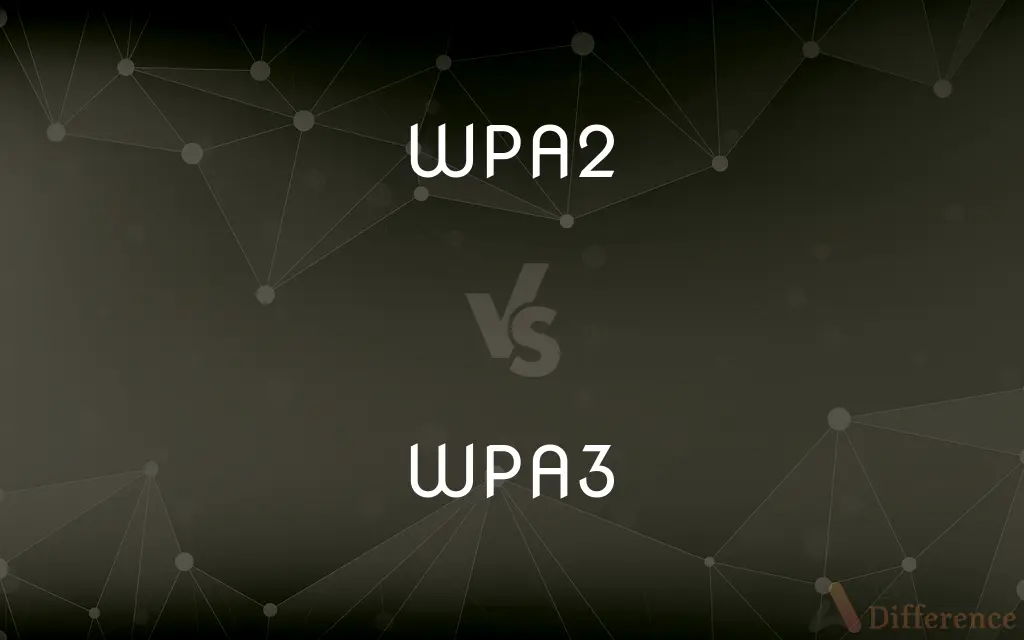WPA2 vs. WPA3 — What's the Difference?
By Tayyaba Rehman — Published on October 21, 2023
WPA2 (Wi-Fi Protected Access 2) and WPA3 are security protocols, with WPA3 providing enhanced cybersecurity features and stronger encryption compared to its predecessor, WPA2.

Difference Between WPA2 and WPA3
Table of Contents
ADVERTISEMENT
Key Differences
The realms of WPA2 and WPA3 elucidate the evolution of Wi-Fi security, embodying the technological strides made to protect wireless networks. WPA2, or Wi-Fi Protected Access 2, has been a stalwart in wireless security since its inception in 2004, bolstering network safety by utilizing AES encryption and facilitating authorized access via a pre-shared password. In contrast, WPA3, inaugurated in 2018, elevates security parameters by introducing stronger encryption methodologies and delivering enhanced protections against brute-force attacks, thereby fortifying wireless network safety.
WPA2, albeit robust during its peak, unveiled vulnerabilities such as the KRACK (Key Reinstallation Attack), illuminating the imperatives for an advanced, impermeable security protocol. WPA3, designed in response to these exigencies, offers robust defenses against potential exploits via Simultaneous Authentication of Equals (SAE), which protects against offline dictionary attacks, thereby presenting a fortified barricade against unauthorized access and security breaches. WPA2, while still extensively used, undeniably reflects a prior era of wireless security, whereas WPA3 mirrors the contemporary demands of cybersecurity.
A salient distinction between WPA2 and WPA3 is underscored in their encryption capabilities, with WPA2 deploying the prevailing, yet somewhat antiquated WPA2-PSK (Pre-Shared Key) employing AES encryption. WPA3 enhances encryption diligence through the usage of a superior, 192-bit security suite, catering particularly to networks transmitting sensitive data, hence presenting a more invulnerable alternative to its predecessor, especially in an organizational context. WPA2 therefore, while effective, may not comply with the elevated security requisites of present-day wireless interactions, as adeptly as WPA3.
Despite the superior securities offered by WPA3, WPA2 continues to dominate numerous devices and networks, attributable to its widespread installation and compatibility with a myriad of devices. WPA3, although it delivers an advanced security spectrum, demands compatible hardware, which can potentially deter its universal adoption and render WPA2 a viable, albeit less secure, alternative for several users and networks. WPA2 thus signifies a globally accepted, albeit slightly aged protocol, while WPA3 reflects the pinnacle of wireless security, albeit with certain adoption barriers.
The transition from WPA2 to WPA3 symbolizes an inevitable technological shift, aspiring to align wireless security protocols with the escalating, complex demands of contemporary digital interactions. WPA2 has effectively shielded wireless networks for numerous years, yet its susceptibilities and inherent limitations prompt the necessity for WPA3, which, with its advanced encryption and superior defenses, seeks to redefine the paradigms of wireless network security. While WPA2 remains prevalent, the eventual, widespread adoption of WPA3 appears indispensable, reflecting the technological and cybersecurity advancements of the digital age.
ADVERTISEMENT
Comparison Chart
Launch Year
2004
2018
Encryption
Uses AES encryption
Utilizes a 192-bit security suite
Authentication
Employs WPA2-PSK
Implements SAE
Vulnerabilities
Susceptible to KRACK
Designed to mitigate known vulnerabilities of WPA2
User Adoption
Widely adopted and compatible with many devices
Slow adoption, requires compatible hardware
Compare with Definitions
WPA2
Known for employing AES encryption.
The AES encryption in WPA2 keeps the network secure.
WPA3
Recognized for employing SAE for authentication.
WPA3’s use of SAE aids in resisting offline dictionary attacks.
WPA2
Recognized for employing a pre-shared key.
To access the network, enter the WPA2 pre-shared key.
WPA3
Known for its advanced 192-bit security suite.
The 192-bit security suite makes WPA3 particularly secure.
WPA2
Introduced in 2004 to enhance Wi-Fi security.
WPA2 has safeguarded Wi-Fi networks for numerous years.
WPA3
Not universally adopted due to hardware requirements.
WPA3 hasn’t been universally adopted due to its compatibility needs.
WPA2
A widely utilized wireless security protocol.
My router supports WPA2 encryption for Wi-Fi protection.
WPA3
Launched in 2018 to mitigate WPA2 vulnerabilities.
WPA3 was developed to provide enhanced cybersecurity features.
WPA2
Noted for vulnerabilities like KRACK.
The KRACK vulnerability exposed WPA2’s security flaws.
WPA3
The succeeding Wi-Fi security protocol after WPA2.
WPA3 introduces fortified encryption and security to networks.
Common Curiosities
Does WPA2 use AES encryption?
Yes, WPA2 employs AES encryption.
What does WPA2 stand for?
Wi-Fi Protected Access 2.
Was WPA2 vulnerable to the KRACK attack?
Yes, WPA2 was susceptible to the KRACK vulnerability.
What distinguishes WPA3’s encryption method?
WPA3 utilizes a robust 192-bit security suite.
Is WPA3 considered more secure than WPA2?
Yes, WPA3 is generally deemed more secure than WPA2.
When was WPA2 introduced?
WPA2 was introduced in 2004.
Is hardware compatibility a concern with WPA3?
Yes, WPA3 demands hardware that supports its features.
Is WPA3 the successor to WPA2?
Yes, WPA3 is the subsequent version of WPA2.
Does WPA3 provide improved protection against brute-force attacks?
Yes, WPA3 introduces SAE, safeguarding against such attacks.
When was WPA3 introduced?
WPA3 was introduced in 2018.
Can devices operating WPA2 connect to WPA3 networks?
Devices need to be WPA3-compatible to connect to WPA3 networks.
Is WPA2 still widely in use?
Yes, WPA2 is still commonly used across numerous devices.
Will WPA3 eventually replace WPA2 entirely?
It is likely, as technology progresses and hardware adapts.
Are WPA2 and WPA3 compatible with each other?
No, devices must support the respective protocol to connect.
Does WPA3 improve upon the vulnerabilities of WPA2?
Yes, WPA3 was designed to mitigate known WPA2 vulnerabilities.
Share Your Discovery

Previous Comparison
Cell Membrane vs. Nuclear Membrane
Next Comparison
Shopping Center vs. Department StoreAuthor Spotlight
Written by
Tayyaba RehmanTayyaba Rehman is a distinguished writer, currently serving as a primary contributor to askdifference.com. As a researcher in semantics and etymology, Tayyaba's passion for the complexity of languages and their distinctions has found a perfect home on the platform. Tayyaba delves into the intricacies of language, distinguishing between commonly confused words and phrases, thereby providing clarity for readers worldwide.










































